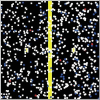A Simulation Study of Coronavirus as an Epidemic Disease Using Agent-Based Modeling
- PMID: 33633517
- PMCID: PMC7883357
A Simulation Study of Coronavirus as an Epidemic Disease Using Agent-Based Modeling
Abstract
At the end of 2019, the world faced the novel coronavirus, and with it fear of economic collapse and mass fatalities. Simulation systems can be used to monitor the behavior of the virus. Simulation provides an abstract representation of reality by conveying details and characteristics of reality in a simple application. One of the most important ways to simulate is agent-based modeling. The health information professional plays an important role in developing these models. In this research, we simulate the spread of COVID-19 in a region restricted to a population with specific demographic characteristics and social relationships. This study aims to clarify the effects of preventative techniques that suppress the spread of epidemics, such as quarantines, social distancing, and reduced mass transit.
Keywords: COVID-19; SIR model; agent-based modeling; coronavirus; epidemic diseases.
Copyright © 2021 by the American Health Information Management Association.
Figures














Similar articles
-
Impacts of reopening strategies for COVID-19 epidemic: a modeling study in Piedmont region.BMC Infect Dis. 2020 Oct 28;20(1):798. doi: 10.1186/s12879-020-05490-w. BMC Infect Dis. 2020. PMID: 33115434 Free PMC article.
-
COVID-19 Spread in Saudi Arabia: Modeling, Simulation and Analysis.Int J Environ Res Public Health. 2020 Oct 23;17(21):7744. doi: 10.3390/ijerph17217744. Int J Environ Res Public Health. 2020. PMID: 33113936 Free PMC article.
-
Public Health Interventions to Mitigate Early Spread of SARS-CoV-2 in Poland.Med Sci Monit. 2020 Apr 13;26:e924730. doi: 10.12659/MSM.924730. Med Sci Monit. 2020. PMID: 32282789 Free PMC article.
-
A modeling and experiment framework for the emergency management in AHC transmission.Comput Math Methods Med. 2014;2014:897532. doi: 10.1155/2014/897532. Epub 2014 Feb 16. Comput Math Methods Med. 2014. PMID: 24693330 Free PMC article. Review.
-
Agent-Based Computational Epidemiological Modeling.J Indian Inst Sci. 2021;101(3):303-327. doi: 10.1007/s41745-021-00260-2. Epub 2021 Oct 5. J Indian Inst Sci. 2021. PMID: 34629766 Free PMC article. Review.
Cited by
-
Generating synthetic population for simulating the spatiotemporal dynamics of epidemics.PLoS Comput Biol. 2024 Feb 12;20(2):e1011810. doi: 10.1371/journal.pcbi.1011810. eCollection 2024 Feb. PLoS Comput Biol. 2024. PMID: 38346079 Free PMC article.
-
COVID-19 simulation study-the effect of strict non-pharmaceutical interventions (NPIs) on controlling the spread of COVID-19.PeerJ. 2021 Mar 30;9:e11172. doi: 10.7717/peerj.11172. eCollection 2021. PeerJ. 2021. PMID: 33850666 Free PMC article.
-
Returning to a Normal Life via COVID-19 Vaccines in the United States: A Large-scale Agent-Based Simulation Study.JMIR Med Inform. 2021 Apr 29;9(4):e27419. doi: 10.2196/27419. JMIR Med Inform. 2021. PMID: 33872188 Free PMC article.
-
A Case Study on the Practical Use of Low-Fidelity Modeling to Mitigate the Spread of COVID-19 Amongst the Underserved Farmworker Community.Mathematica (N Y). 2023;2(1):223-241. doi: 10.1007/s44007-023-00043-4. Epub 2023 Feb 22. Mathematica (N Y). 2023. PMID: 36852263 Free PMC article.
-
Statistical analysis of the community lockdown for COVID-19 pandemic.Appl Intell (Dordr). 2022;52(4):3465-3482. doi: 10.1007/s10489-021-02615-9. Epub 2021 Jul 7. Appl Intell (Dordr). 2022. PMID: 34764609 Free PMC article.
References
-
- Main website. Accessed March 2020. Available at: www.who.int.
-
- COVID-19 Coronavirus Pandemic. Accessed March 2020. Available at: www.worldometers.info/coronavirus.
-
- Tableau Visualization Toolkit. Online. Accessed February 11, 2020.
MeSH terms
LinkOut - more resources
Full Text Sources
